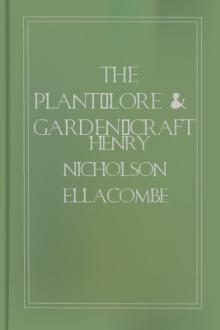The plant-lore & garden-craft of Shakespear, Henry Nicholson Ellacombe [read with me .TXT] 📗

- Author: Henry Nicholson Ellacombe
- Performer: -
Book online «The plant-lore & garden-craft of Shakespear, Henry Nicholson Ellacombe [read with me .TXT] 📗». Author Henry Nicholson Ellacombe
[194:1] "Names of Herbes," s.v. Palma.
[195:1] In connection with this, Turner's account of the Palm in 1538 is worth quoting: "Palmā arborem in anglia nunq' me vidisse memini. Indie tamen ramis palmarū (ut illi loqūntur) sœpius sacerdotē dicentē andivi. Bendic etiā et hos palmarū ramos, quū prœter salignas frondes nihil omnino viderē ego, quid alii viderint nescio. Si nobis palmarum frondes non suppeterent; prœstaret me judice mutare lectionem et dicere. Benedic hos salicū ramos q' falso et mendaciter salicum frondes palmarum frondes vocare."—Libellus, De re Herbaria, s.v. Palma.
PANSIES. (1) Ophelia. And there is Pansies—that's for thoughts. Hamlet, act iv, sc. 5 (176). (2) Lucentio. But see, while idly I stood looking on,I found the effect of Love-in-idleness. Taming of the Shrew, act i, sc. 1 (155). (3) Oberon. Yet mark'd I where the bolt of Cupid fell:
It fell upon a little western flower,
Before milk-white, now purple with love's wound,
And maidens call it Love-in-idleness.
Fetch me that flower; the herb I show'd thee once;
The juice of it on sleeping eye-lids laid
Will make or man or woman madly dote
Upon the next live creature that it sees. Midsummer Night's Dream, act ii, sc. 1 (165). (4) Oberon. Dian's Bud o'er Cupid's flower
Hath such free and blessed power. Ibid., act iv, sc. 1 (78).
The Pansy is one of the oldest favourites in English gardens, and the affection for it is shown in the many names that were given to it. The Anglo-Saxon name was Banwort or Bonewort, though why such a name was given to it we cannot now say. Nor can we satisfactorily explain its common names of Pansy or Pawnce (from the French, pensées—"that is, for thoughts," says Ophelia), or Heart's-ease,[196:1] which name was originally given to the Wallflower. The name Cupid's flower seems to be peculiar to Shakespeare, but the other name, Love-in-idle, or idleness, is said to be still in use in Warwickshire, and signifies love in vain, or to no purpose, as in Chaucer: "The prophet David saith; If God ne kepe not the citee, in ydel waketh he that keptit it."[196:2] And in Tyndale's translation of the New Testament, "I have prechid to you, if ye holden, if ye hav not bileved ideli" (1 Cor. xv. 2). "Beynge plenteuous in werk of the Lord evermore, witynge that youre traveil is not idel in the Lord" (1 Cor. xv. 58).
But beside these more common names, Dr. Prior mentions the following: "Herb Trinity, Three faces under a hood, Fancy, Flamy,[197:1] Kiss me, Cull me or Cuddle me to you, Tickle my fancy, Kiss me ere I rise, Jump up and kiss me, Kiss me at the garden gate, Pink of my John, and several more of the same amatory character."
Spenser gives the flower a place in his "Royal aray" for Elisa—
And Cowslips, and Kingcups, and loved Lillies,
The pretie Pawnce,
And the Chevisaunce
Shall match with the fayre Flower Delice."
And in another place he speaks of the "Paunces trim"—F. Q., iii. 1. Milton places it in Eve's couch—
Pansies, and Violets, and Asphodel,
And Hyacinth, earth's freshest, softest lap."
He names it also as part of the wreath of Sabrina—
and as one of the flowers to strew the hearse of Lycidas—
The glowing Violet."
FOOTNOTES:
[196:1] "The Pansie Heart's ease Maiden's call."—Drayton Ed., ix.
[196:2] And again—
Take not in ydel my name or amys."
Pardeners Tale.
Ledest this world by certein governance,
In idel, as men sein, ye nothinge make."
The Frankelynes Tale.
[197:1] "Flamy, because its colours are seen in the flame of wood."—Flora Domestica, 166.
PARSLEY. Biondello. I knew a wench married in an afternoon as she went to the garden for Parsley to stuff a rabbit. Taming of the Shrew, act iv, sc 4 (99).Parsley is the abbreviated form of Apium petroselinum, and is a common name to many umbelliferous plants, but the garden Parsley is the one meant here. This well-known little plant has the curious botanic history that no one can tell what is its native country. In 1548 Turner said, "Perseley groweth nowhere that I knowe, but only in gardens."[198:1] It is found in many countries, but is always considered an escape from cultivation. Probably the plant has been so altered by cultivation as to have lost all likeness to its original self.
Our forefathers seem to have eaten the parsley root as well as the leaves—
Right so bygyn your mele."
Russell's Boke of Nurture, 826.
Wynkyn de Worde's Boke of Kervynge.
FOOTNOTES:[198:1] "Names of Herbes," s.v. Apium.
PEACH (1) Prince Henry. To take note how many pair of silk stockings thou hast, viz., these, and those that were thy Peach-coloured ones! 2nd Henry IV, act ii, sc. 2 (17). (2) Pompey. Then there is here one Master Caper, at the suit of Master Threepile the mercer, for some four suits of Peach-coloured satin, which now peaches him a beggar. Measure for Measure, act iv, sc. 3 (10).The references here are only to the colour of the Peach blossom, yet the Peach tree was a well-known tree in Shakespeare's time, and the fruit was esteemed a great delicacy, and many different varieties were cultivated. Botanically the Peach is closely allied to the Almond, and still more closely to the Apricot and Nectarine; indeed, many writers consider both the Apricot and Nectarine to be only varieties of the Peach.
The native country of the Peach is now ascertained to be China, and not Persia, as the name would imply. It probably came to the Romans through Persia, and was by them introduced into England. It occurs in Archbishop's Ælfric's "Vocabulary" in the tenth century, "Persicarius, Perseoctreow;" and John de Garlande grew it in the thirteenth century, "In virgulto Magistri Johannis, pessicus fert pessica." It is named in the "Promptorium Parvulorum" as "Peche, or Peske, frute—Pesca Pomum Persicum;" and in a note the Editor says: "In a role of purchases for the Palace of Westminster preserved amongst the miscellaneous record of the Queen's remembrance, a payment occurs, Will le Gardener, pro iij koygnere, ij pichere iijs.—pro groseillere iijd, pro j peschere vjd." a.d. 1275, 4 Edw: 1—
We all know and appreciate the fruit of the Peach, but few seem to know how ornamental a tree is the Peach, quite independent of the fruit. In those parts where the soil and climate are suitable, the Peach may be grown as an ornamental spring flowering bush. When so grown preference is generally given to the double varieties, of which there are several, and which are not by any means the new plants that they are generally supposed to be, as they were cultivated both by Gerard and Parkinson.
PEAR. (1) Falstaff. I warrant they would whip me with their fine wits till I were as crest-fallen as a dried Pear. Merry Wives of Windsor, act iv, sc. 5 (101). (2) Parolles. Your virginity, your old virginity, is like one of our French withered Pears, it looks ill, it eats drily; marry, 'tis a withered Pear; it was formerly better; marry, yet 'tis a withered Pear. All's Well that Ends Well, act i, sc. 1 (174). (3) Clown. I must have Saffron to colour the Warden pies. Winter's Tale, act iv, sc. 3 (48). (4) Mercutio. O, Romeo . . . thou a Poperin Pear. Romeo and Juliet, act ii, sc. 1 (37).If we may judge by these few notices, Shakespeare does not seem to have had much respect for the Pear, all the references to the fruit being more or less absurd or unpleasant. Yet there were good Pears in his day, and so many different kinds that Gerard declined to tell them at length, for "the stocke or kindred of Pears are not to be numbered; every country hath his peculiar fruit, so that to describe them apart were to send an owle to Athens, or to number those things that are without number."
Of these many sorts Shakespeare mentions by name but two, the Warden and the Poperin, and it is not possible to identify these with modern varieties with any certainty. The Warden was probably a general name for large keeping and stewing Pears, and the name was said to come from the Anglo-Saxon wearden, to keep or preserve, in allusion to its lasting qualities. But this is certainly a mistake. In an interesting paper by Mr. Hudson Turner, "On the State of Horticulture in England in early times, chiefly previous to the fifteenth century," printed in the "Archæological Journal," vol. v. p. 301, it is stated that "the Warden Pear had its origin and its name from the horticultural skill of the Cistercian Monks of Wardon Abbey in Bedfordshire, founded in the twelfth century. Three Warden Pears appeared in the armorial bearings of the Abbey."
It was certainly an early name. In the "Catholicon Anglicum" we find: "A Parmayn, volemum, Anglice, a Warden;" and in Parkinson's time the name was still in use, and he mentions two varieties, "The Warden or Lukewards Pear are of two sorts, both white and red, both great and small." (The name of Lukewards seems to point to St. Luke's Day, October 18, as perhaps the time either for picking the fruit or for its ripening.) "The Spanish Warden is greater than either of both the former, and better also." And he further says: "The Red Warden and the Spanish Warden are reckoned amongst the most excellent of Pears, either to bake or to roast, for the sick or for the sound—and indeed the Quince and the Warden are the only two fruits that are permitted to the sick to eat at any time." The Warden pies of Shakespeare's day, coloured with Saffron, have in our day been replaced by stewed Pears coloured with Cochineal.[200:1]
I can find no guide to the identification of the Poperin Pear, beyond Parkinson's description: "The summer Popperin and the winter Popperin, both of them very good, firm, dry Pears, somewhat spotted and brownish on the outside. The green Popperin is a winter fruit of equal goodnesse with the former." It was probably a Flemish Pear, and may have been introduced by the antiquary Leland, who was made Rector of Popering by Henry VIII. The place is further known to us as mentioned by Chaucer—
In batail and in tornament,
His name was Sir Thopas.
Alone he was in fer contre,
In Flaundres, all beyonde the se,
At Popering in the place."
As a garden tree the Pear is not only to be grown for its fruit, but as a most ornamental tree. Though the individual flowers are not, perhaps, so handsome as the





Comments (0)